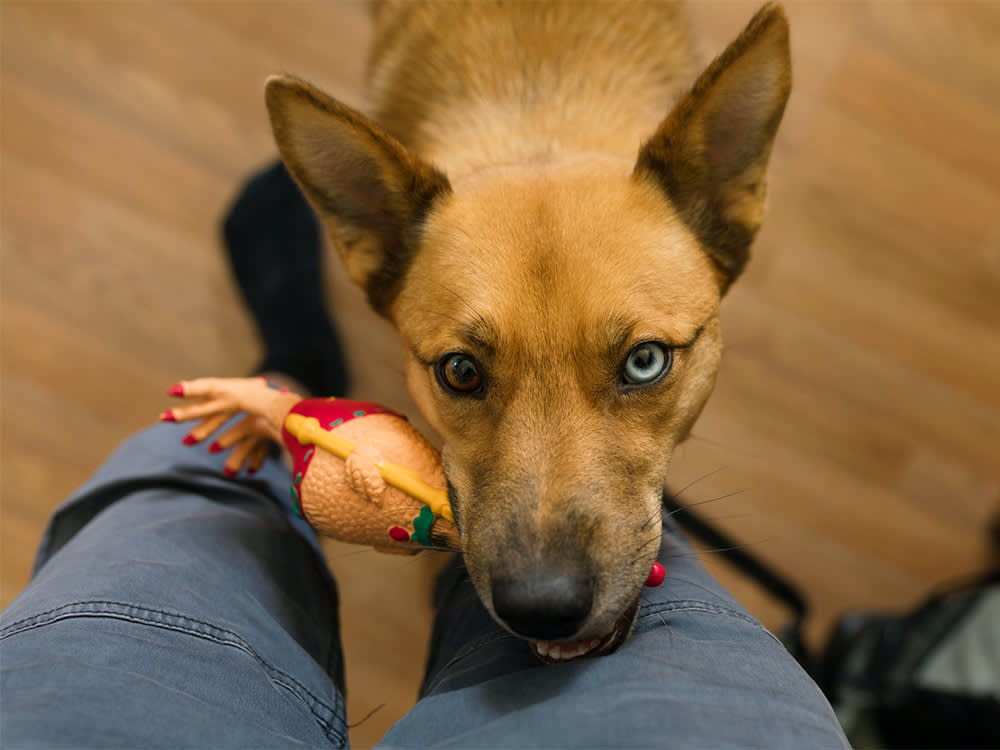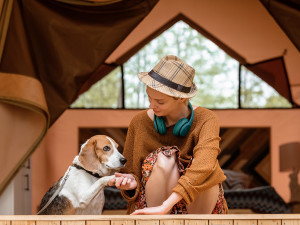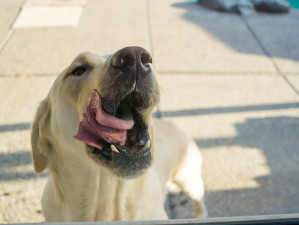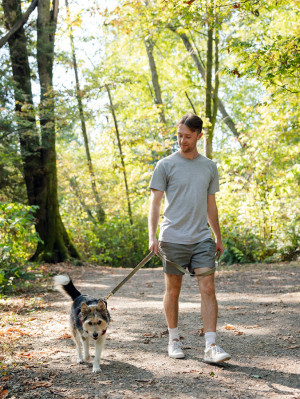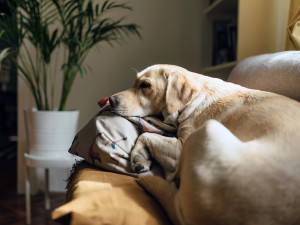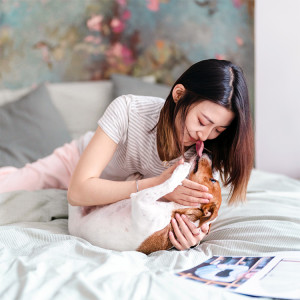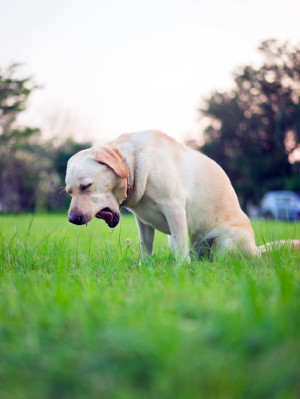What Is Displacement Behaviour In Dogs?
And should you be worried?
As devoted dog parents, we watch our beloved furry friends engage in a myriad of behaviours, each offering a glimpse into their unique personalities. Among the playful antics and heartwarming gestures (and sometimes downright bizarre behavioursopens in a new tab), some actions – known as displacement behaviours – can provide profound insights into canine psychology.
Recognising displacement behaviour in dogs is key for conscientious pet parents striving to cultivate a harmonious relationship with their canine companions. By familiarising themselves with common displacement behaviours, discerning their triggers and underlying causes, and implementing tailored strategies to mitigate them, dog parents can foster a positive environment to allow their pet to flourish.
littleKin™ is Kinship’s home just for puppy and kitten parents. Bop over to check out expert advice, new pet tools, and special deals—all curated for your newest family member.
opens in a new tabWhat is displacement behaviour?
Displacement behaviours, though seemingly innocuous, signify moments of heightened emotional arousal in dogs, manifesting as ordinary actions exhibited at unconventional times. These behaviours can often occur when a dog is feeling anxiousopens in a new tab, stressed, frustrated or overly excited, and happen at times when the actions seem out of place or contextually inappropriate. These self-soothing behaviours can serve as invaluable signals for dog parents, offering vital clues to deciphering and addressing their pet's emotional well-being.
Examples of displacement behaviours
Often displacement behaviours seem like perfectly normal actions and activities, and can include yawning, lip licking, shaking as if wet (when dry), stretching, sneezingopens in a new tab, excessive licking or scratching, and sniffing the ground. These behaviours might seem ordinary in different contexts but become more likely to be displaced, self-soothing signs when displayed out of context or in stressful situations.
“Most people have heard of fight or flight, but there are two more fear responses that dogs may display: freeze and fidget”, says Susan Nilson, editor, author, animal behaviour consultant and founder of The Cat and Dog Houseopens in a new tab. Susan says ‘freeze’ is fairly self-explanatory but the ‘fidget’ part? That’s usually a displacement behaviour.
Some of the most common displacement behaviours include:
Yawning and lip licking
Whilst yawning is typically associated with tiredness, dogs may exhibit this behaviour when experiencing stress or uncertainty in unfamiliar environments or social situations. Similarly, lip licking serves as a self-soothing mechanism for dogs under stress, helping to alleviate anxiety or discomfort.
Excessive licking or scratching
Excessive lickingopens in a new tab or scratching is another displacement behaviour often displayed by dogs in response to heightened emotional states. Dogs may lick or scratch excessively when faced with stressful situations, such as visits to the vet or encounters with unfamiliar dogs.
Sniffing and shaking off
Dogs use behaviours such as sniffing the ground or shaking offopens in a new tab as if wet (when dry) to release tension and reduce anxiety. These actions help dogs cope with stressful or overwhelming environments by diverting their focus and relieving emotional arousal.
Bringing you things
Does your pup go and get a toy as soon as you come home? Bringing their pet parents items such as toys or sometimes shoes can be a way for dogs to cope with their big feelings and emotions – excitement and joy at the fact you’re home – by channelling them into an inanimate object, instead of jumping up at you (which they know their not supposed to do), for example.
How do I know what’s ‘normal’ and what’s a displacement behaviour?
Differentiating between normal canine behaviours and displacement behaviours requires careful observation of the context and the dog’s overall body language, advises Rachel Forday, dog trainer and founder of Dog At Heartopens in a new tab. For instance, a dog grooming themselves after a meal at home may be exhibiting natural behaviour, while a dog licking themselves frantically during a training session might be displaying displacement behaviour due to confusion or frustration, they add.
“A yawn as your dog goes to sleep or wakes up is very normal, but a yawn as they walk into the vets or play with a dog friend doesn’t make sense as we know that they aren’t thinking about taking a nap in those situations,” adds Dr Katie Friel-Russell, a veterinary behaviourist and head trainer at Positive Pet Training.opens in a new tab
What are the causes of displacement behaviour?
The most common displacement behaviour trigger is fear-based anxiety in high-stress situations. “Any of these displacement behaviours can serve as a way for dogs to self-soothe and attempt to defuse stress,” says Susan. “It’s similar to the way we humans might bite our nails or fiddle with our hair when nervous.”
Displacement behaviours in dogs can be triggered by various factors, including:
Social uncertainty: dogs may exhibit displacement behaviours when uncertain about how to react in social situations, such as meeting new dogs or people.
Unfamiliar environments: new or unfamiliar environments can provoke displacement behaviours as dogs navigate different surroundings and stimuli.
Blocked desires: situations where a dog’s desires are obstructed, such as being restrained on a lead or unable to reach something they want, can lead to displacement behaviours.
Mixed signals: conflicting signals from parents or aversive training methods can create confusion and stress for dogs, prompting displacement behaviours.
Triggers of displacement behaviours will vary depending on the dog, and it’s important to note your pup’s own body language in each situation so you can narrow down some of the causes.
Addressing displacement behaviours
If you notice displacement behaviours in your dog, there’s no need to panic. These behaviours can occur even when your dog is having a good time, too, so it doesn’t mean they’re unhappy. “Your dog is going to have emotional fluctuations throughout the day and that can be completely normal,” says Dr Friel-Russell.
However, displacement behaviours do often indicate a need to calm things down; they serve as warning signs that your dog is reaching their tolerance level and may react in a more significant way if the situation persists. “Displacement behaviours are our warning signs that more severe behaviours are coming and we need to listen,” adds Dr Friel-Russell.
“They appear as your dog is reaching their threshold, or tolerance level, and if they stay in that situation they are likely to react in a bigger way with high arousal behaviours such as mouthing, jumping up and barking or worsening behaviours driven by negative emotions such as lunging, growlingopens in a new tab, snapping and biting.”
You can take a break from excitable play and engage in intentional calming activities such as chewing or sniffing to help your dog relax. If displacement behaviours persist in specific situations, it’s crucial to address the underlying issues. This may involve helping your dog build confidence in those areas or modifying their environment to reduce stressors:
Calming activities: engaging in intentional calming activities such as chewing or sniffing can help alleviate displacement behaviours and reduce emotional arousal in dogs. These activities provide dogs with an outlet for stress relief and promote relaxation in tense situations.
Confidence building: addressing underlying confidence issues through positive reinforcement training and gradual exposure to stressors can help reduce displacement behaviours in dogs. By building their confidence in challenging environments or social situations, dogs can learn to cope more effectively and exhibit fewer displacement behaviours.
Environmental modifications: modifying the dog’s environment to reduce stressors and create a more comfortable atmosphere can also help manage displacement behaviours. This may involve minimising exposure to triggering stimuli, providing safe spaces for retreat and maintaining a consistent routine to promote stability and security.
Often, displacement behaviours can also dissipate on their own as the underlying issues are treated, or as the dog’s confidence increases in certain situations. As Susan explains, when she adopted her very shutdown rescue dog, Florence, she kept her nose glued to the ground the entire time whenever Susan took her out for a walk.
“Although she is somewhat scent-driven, she no longer does this now she is happy and settled. But in those early days, her excessive sniffing was also part displacement behaviour to cope with the stress of being with a complete stranger (me), in a totally unfamiliar environment where she didn’t yet know if she was safe.”
